University Case Study: Colorectal Cancer and Anaemia in Adult Health 2
VerifiedAdded on 2023/01/06
|10
|3377
|76
Case Study
AI Summary
This case study examines a 56-year-old patient, Amanda Johnson, presenting with lethargy, reduced exercise tolerance, and altered bowel habits, who was diagnosed with anaemia and a family history of colorectal cancer. The assignment delves into the pathophysiology and diagnosis of colorectal cancer, analyzing Amanda's blood results and potential causes of her anaemia, considering her diet, lifestyle, and comorbidities such as rheumatoid arthritis and hypertension. It discusses the pharmacology of her prescribed medications, including Methotrexate, Ibuprofen, and Ramipril, detailing their mechanisms of action, dosages, and potential adverse effects. Furthermore, the assignment explores specific nursing care, emphasizing evidence-based research for pre-procedure preparation and discharge education, considering Amanda's co-morbidities and associated risk factors to optimize patient outcomes and reduce complications. The analysis incorporates relevant literature and research to support the nursing interventions and patient management strategies, providing a comprehensive understanding of the case.
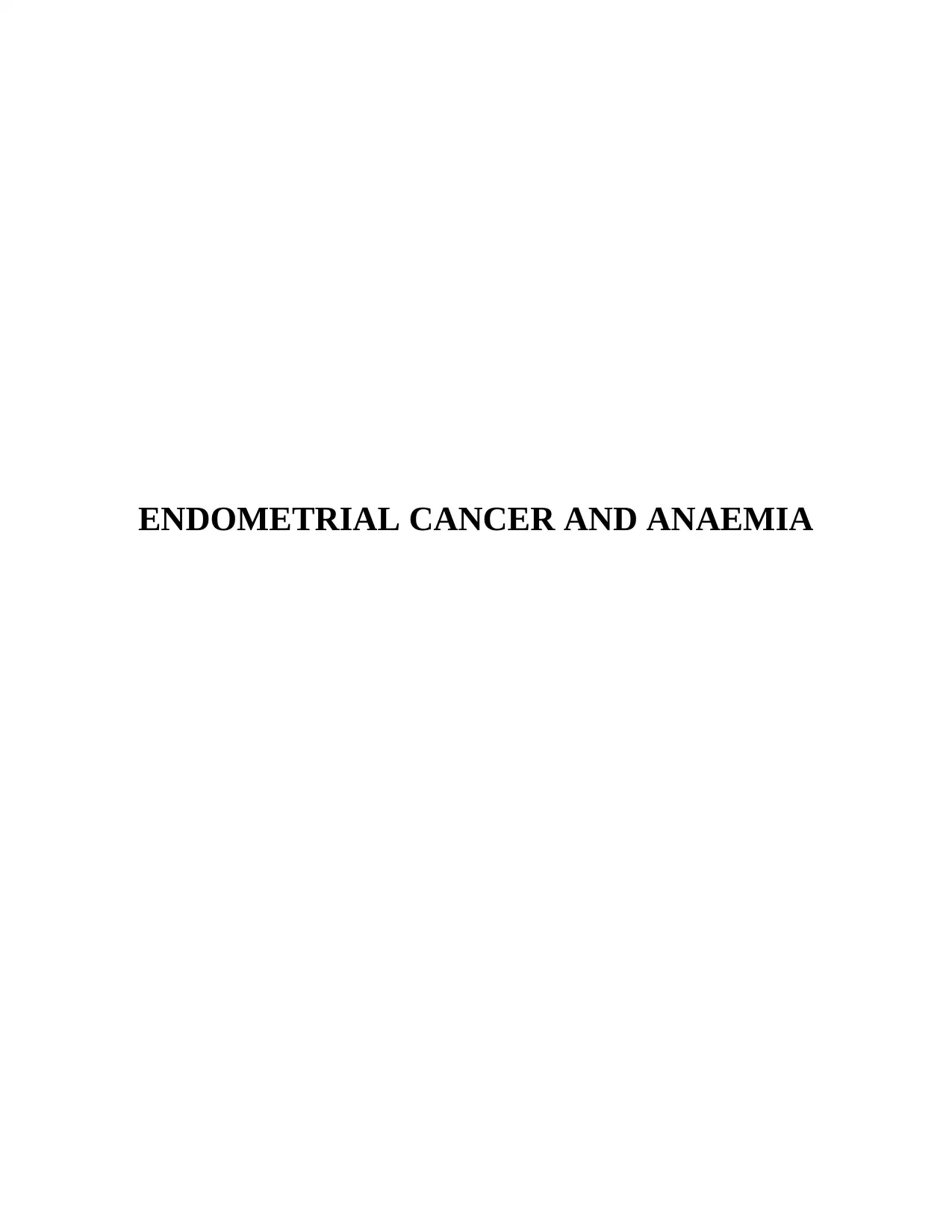
ENDOMETRIAL CANCER AND ANAEMIA
Paraphrase This Document
Need a fresh take? Get an instant paraphrase of this document with our AI Paraphraser
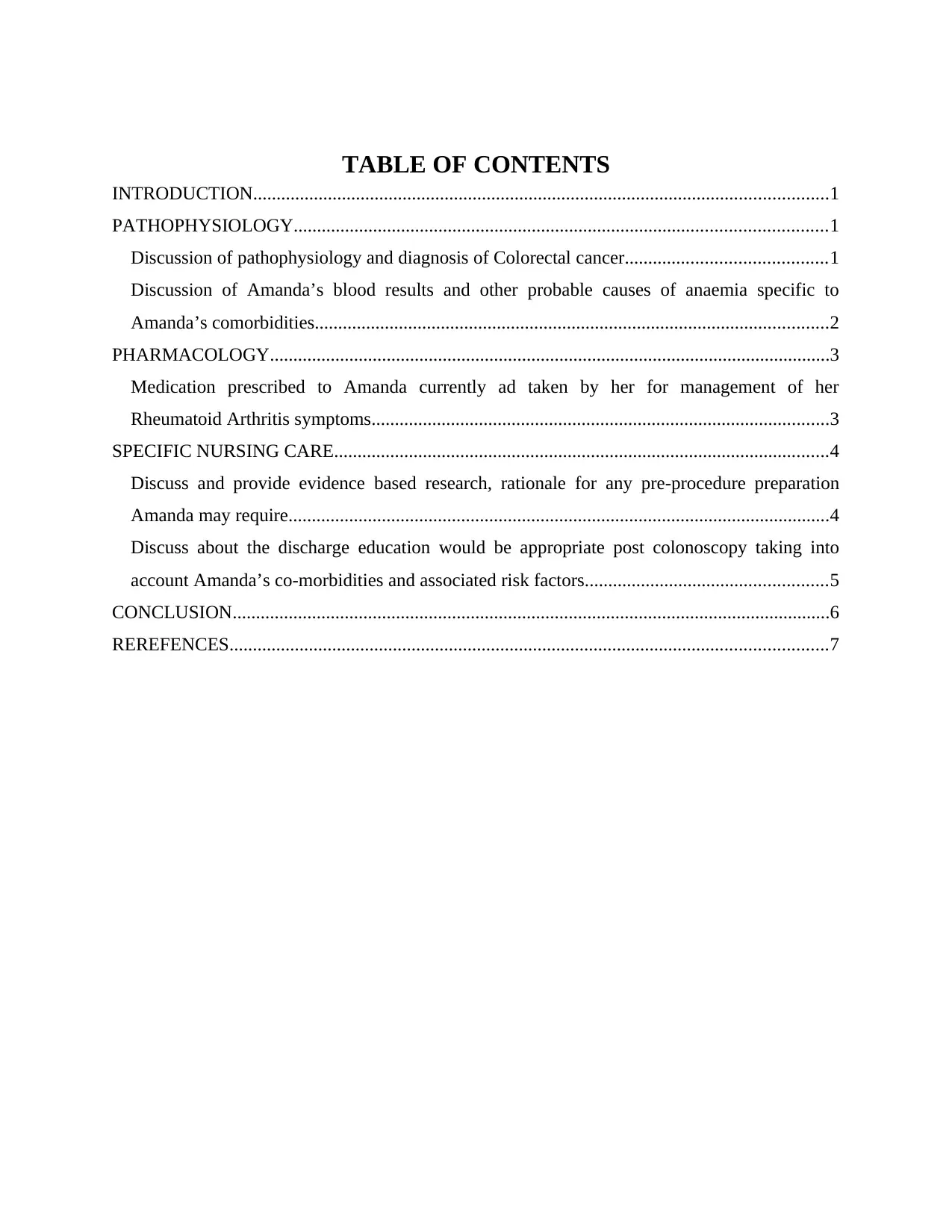
TABLE OF CONTENTS
INTRODUCTION...........................................................................................................................1
PATHOPHYSIOLOGY..................................................................................................................1
Discussion of pathophysiology and diagnosis of Colorectal cancer...........................................1
Discussion of Amanda’s blood results and other probable causes of anaemia specific to
Amanda’s comorbidities..............................................................................................................2
PHARMACOLOGY........................................................................................................................3
Medication prescribed to Amanda currently ad taken by her for management of her
Rheumatoid Arthritis symptoms..................................................................................................3
SPECIFIC NURSING CARE..........................................................................................................4
Discuss and provide evidence based research, rationale for any pre-procedure preparation
Amanda may require....................................................................................................................4
Discuss about the discharge education would be appropriate post colonoscopy taking into
account Amanda’s co-morbidities and associated risk factors....................................................5
CONCLUSION................................................................................................................................6
REREFENCES................................................................................................................................7
INTRODUCTION...........................................................................................................................1
PATHOPHYSIOLOGY..................................................................................................................1
Discussion of pathophysiology and diagnosis of Colorectal cancer...........................................1
Discussion of Amanda’s blood results and other probable causes of anaemia specific to
Amanda’s comorbidities..............................................................................................................2
PHARMACOLOGY........................................................................................................................3
Medication prescribed to Amanda currently ad taken by her for management of her
Rheumatoid Arthritis symptoms..................................................................................................3
SPECIFIC NURSING CARE..........................................................................................................4
Discuss and provide evidence based research, rationale for any pre-procedure preparation
Amanda may require....................................................................................................................4
Discuss about the discharge education would be appropriate post colonoscopy taking into
account Amanda’s co-morbidities and associated risk factors....................................................5
CONCLUSION................................................................................................................................6
REREFENCES................................................................................................................................7

INTRODUCTION
Endometrial cancer is a type of disease that mainly starts when cells in the endometrium to
grow out of control and spread too other part of body. On the other hand, Anaemia is based on
the condition that develops when blood lacks enough healthy red cells.
The report is based on the case study related the Colorectal Cancer and anaemia, Amanda
Johnson aged 56 presented to her general practitioners. Amanda client has a specific diet that is
red meat and processed food or drinks. The documentation will describe about the concept of
pathophysiology and diagnosis colorectal cancer. Furthermore, it will identify the blood results
and what are causes of anaemia. The report will discuss about the medications and take help for
managing its current Rheumatoid Arthritis Symptoms, identifying the different action, ADR’s
and dosage. At last, it will conduct the evidence based research on the pre-procedure for
medication and also considered the discharge education to reduce risk factors.
PATHOPHYSIOLOGY
Discussion of pathophysiology and diagnosis of Colorectal cancer
Pathophysiology and diagnosis of Colorectal cancer
There are various kinds of genetic factors like family medical history and environmental
factors that can result in development of colorectal cancer. Due to these factors high probability
of hallmark acquisition of cancerous behaviour in colon epigenetic cell are promoted. This
further results in activation of potential cancerous traits and deactivates genes that are suppose to
prevent development of tumour. It has also been observed that due to abnormal growth od
cancerous cells loss of epigenetic modifications on the genetic material of a cell in colon has
been observed. This pathophysiological event results in formation of colorectal cancer.
Pathophysiological changes that may have contributed to Amanda’s anaemia
Pathophysiology of amnesia varies with extent of damage in different damaged region of
brain. Medial temporal lobe, basal forebrain, and fornix ae well described regions of brain that
can help n understanding development of amnesia. A particular reason because of which amnesia
is caused is still not identified but it can develop and spread because of pre- existing medical
conditions and can develop permanently.
There is no particular or exact cause of colorectal cancer, but there are various kinds of
risk factors that results in development of this disease such as: tobacco smoking, heavy alcohol
use, family history or certain hereditary cancer syndromes of colorectal cancer. people with these
1
Endometrial cancer is a type of disease that mainly starts when cells in the endometrium to
grow out of control and spread too other part of body. On the other hand, Anaemia is based on
the condition that develops when blood lacks enough healthy red cells.
The report is based on the case study related the Colorectal Cancer and anaemia, Amanda
Johnson aged 56 presented to her general practitioners. Amanda client has a specific diet that is
red meat and processed food or drinks. The documentation will describe about the concept of
pathophysiology and diagnosis colorectal cancer. Furthermore, it will identify the blood results
and what are causes of anaemia. The report will discuss about the medications and take help for
managing its current Rheumatoid Arthritis Symptoms, identifying the different action, ADR’s
and dosage. At last, it will conduct the evidence based research on the pre-procedure for
medication and also considered the discharge education to reduce risk factors.
PATHOPHYSIOLOGY
Discussion of pathophysiology and diagnosis of Colorectal cancer
Pathophysiology and diagnosis of Colorectal cancer
There are various kinds of genetic factors like family medical history and environmental
factors that can result in development of colorectal cancer. Due to these factors high probability
of hallmark acquisition of cancerous behaviour in colon epigenetic cell are promoted. This
further results in activation of potential cancerous traits and deactivates genes that are suppose to
prevent development of tumour. It has also been observed that due to abnormal growth od
cancerous cells loss of epigenetic modifications on the genetic material of a cell in colon has
been observed. This pathophysiological event results in formation of colorectal cancer.
Pathophysiological changes that may have contributed to Amanda’s anaemia
Pathophysiology of amnesia varies with extent of damage in different damaged region of
brain. Medial temporal lobe, basal forebrain, and fornix ae well described regions of brain that
can help n understanding development of amnesia. A particular reason because of which amnesia
is caused is still not identified but it can develop and spread because of pre- existing medical
conditions and can develop permanently.
There is no particular or exact cause of colorectal cancer, but there are various kinds of
risk factors that results in development of this disease such as: tobacco smoking, heavy alcohol
use, family history or certain hereditary cancer syndromes of colorectal cancer. people with these
1
⊘ This is a preview!⊘
Do you want full access?
Subscribe today to unlock all pages.

Trusted by 1+ million students worldwide
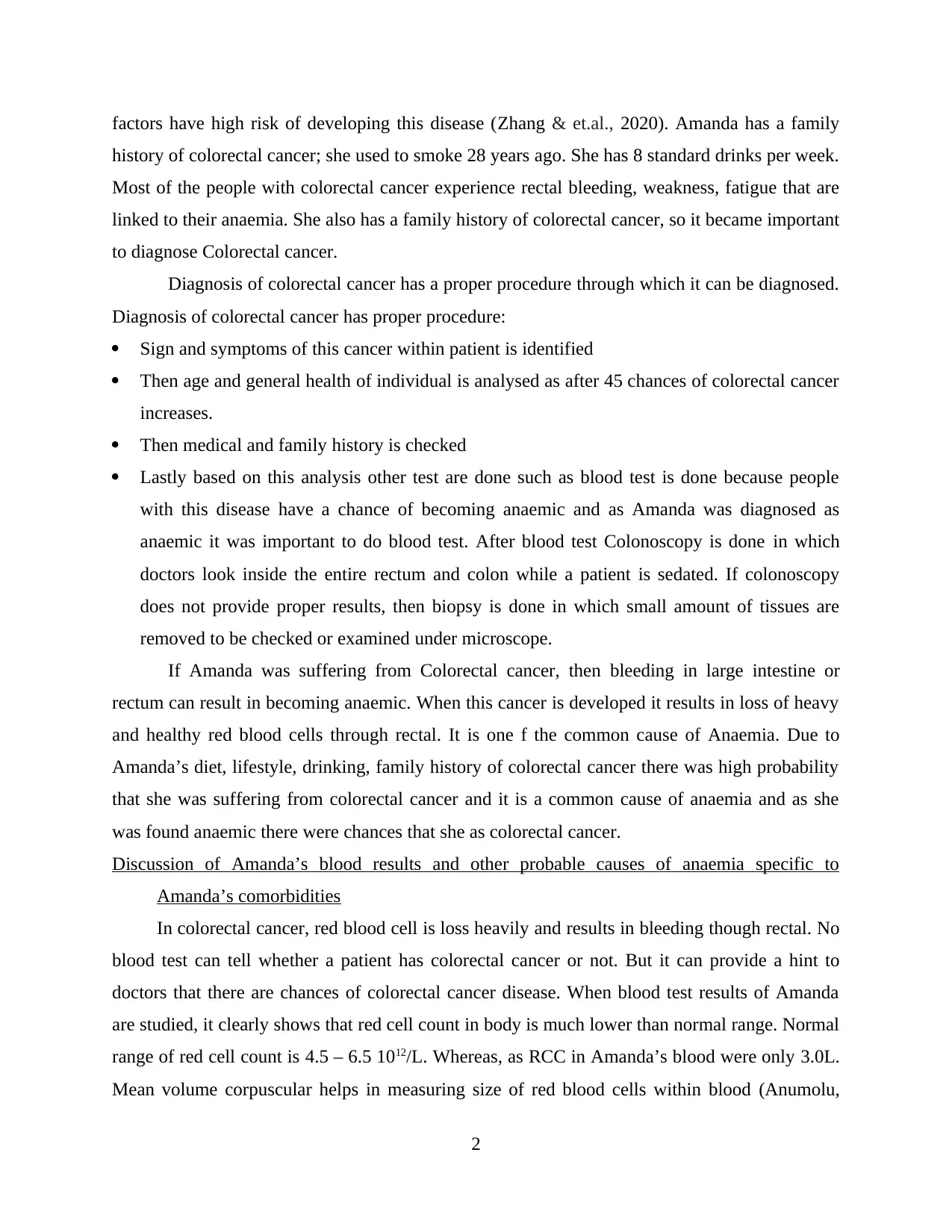
factors have high risk of developing this disease (Zhang & et.al., 2020). Amanda has a family
history of colorectal cancer; she used to smoke 28 years ago. She has 8 standard drinks per week.
Most of the people with colorectal cancer experience rectal bleeding, weakness, fatigue that are
linked to their anaemia. She also has a family history of colorectal cancer, so it became important
to diagnose Colorectal cancer.
Diagnosis of colorectal cancer has a proper procedure through which it can be diagnosed.
Diagnosis of colorectal cancer has proper procedure:
Sign and symptoms of this cancer within patient is identified
Then age and general health of individual is analysed as after 45 chances of colorectal cancer
increases.
Then medical and family history is checked
Lastly based on this analysis other test are done such as blood test is done because people
with this disease have a chance of becoming anaemic and as Amanda was diagnosed as
anaemic it was important to do blood test. After blood test Colonoscopy is done in which
doctors look inside the entire rectum and colon while a patient is sedated. If colonoscopy
does not provide proper results, then biopsy is done in which small amount of tissues are
removed to be checked or examined under microscope.
If Amanda was suffering from Colorectal cancer, then bleeding in large intestine or
rectum can result in becoming anaemic. When this cancer is developed it results in loss of heavy
and healthy red blood cells through rectal. It is one f the common cause of Anaemia. Due to
Amanda’s diet, lifestyle, drinking, family history of colorectal cancer there was high probability
that she was suffering from colorectal cancer and it is a common cause of anaemia and as she
was found anaemic there were chances that she as colorectal cancer.
Discussion of Amanda’s blood results and other probable causes of anaemia specific to
Amanda’s comorbidities
In colorectal cancer, red blood cell is loss heavily and results in bleeding though rectal. No
blood test can tell whether a patient has colorectal cancer or not. But it can provide a hint to
doctors that there are chances of colorectal cancer disease. When blood test results of Amanda
are studied, it clearly shows that red cell count in body is much lower than normal range. Normal
range of red cell count is 4.5 – 6.5 1012/L. Whereas, as RCC in Amanda’s blood were only 3.0L.
Mean volume corpuscular helps in measuring size of red blood cells within blood (Anumolu,
2
history of colorectal cancer; she used to smoke 28 years ago. She has 8 standard drinks per week.
Most of the people with colorectal cancer experience rectal bleeding, weakness, fatigue that are
linked to their anaemia. She also has a family history of colorectal cancer, so it became important
to diagnose Colorectal cancer.
Diagnosis of colorectal cancer has a proper procedure through which it can be diagnosed.
Diagnosis of colorectal cancer has proper procedure:
Sign and symptoms of this cancer within patient is identified
Then age and general health of individual is analysed as after 45 chances of colorectal cancer
increases.
Then medical and family history is checked
Lastly based on this analysis other test are done such as blood test is done because people
with this disease have a chance of becoming anaemic and as Amanda was diagnosed as
anaemic it was important to do blood test. After blood test Colonoscopy is done in which
doctors look inside the entire rectum and colon while a patient is sedated. If colonoscopy
does not provide proper results, then biopsy is done in which small amount of tissues are
removed to be checked or examined under microscope.
If Amanda was suffering from Colorectal cancer, then bleeding in large intestine or
rectum can result in becoming anaemic. When this cancer is developed it results in loss of heavy
and healthy red blood cells through rectal. It is one f the common cause of Anaemia. Due to
Amanda’s diet, lifestyle, drinking, family history of colorectal cancer there was high probability
that she was suffering from colorectal cancer and it is a common cause of anaemia and as she
was found anaemic there were chances that she as colorectal cancer.
Discussion of Amanda’s blood results and other probable causes of anaemia specific to
Amanda’s comorbidities
In colorectal cancer, red blood cell is loss heavily and results in bleeding though rectal. No
blood test can tell whether a patient has colorectal cancer or not. But it can provide a hint to
doctors that there are chances of colorectal cancer disease. When blood test results of Amanda
are studied, it clearly shows that red cell count in body is much lower than normal range. Normal
range of red cell count is 4.5 – 6.5 1012/L. Whereas, as RCC in Amanda’s blood were only 3.0L.
Mean volume corpuscular helps in measuring size of red blood cells within blood (Anumolu,
2
Paraphrase This Document
Need a fresh take? Get an instant paraphrase of this document with our AI Paraphraser
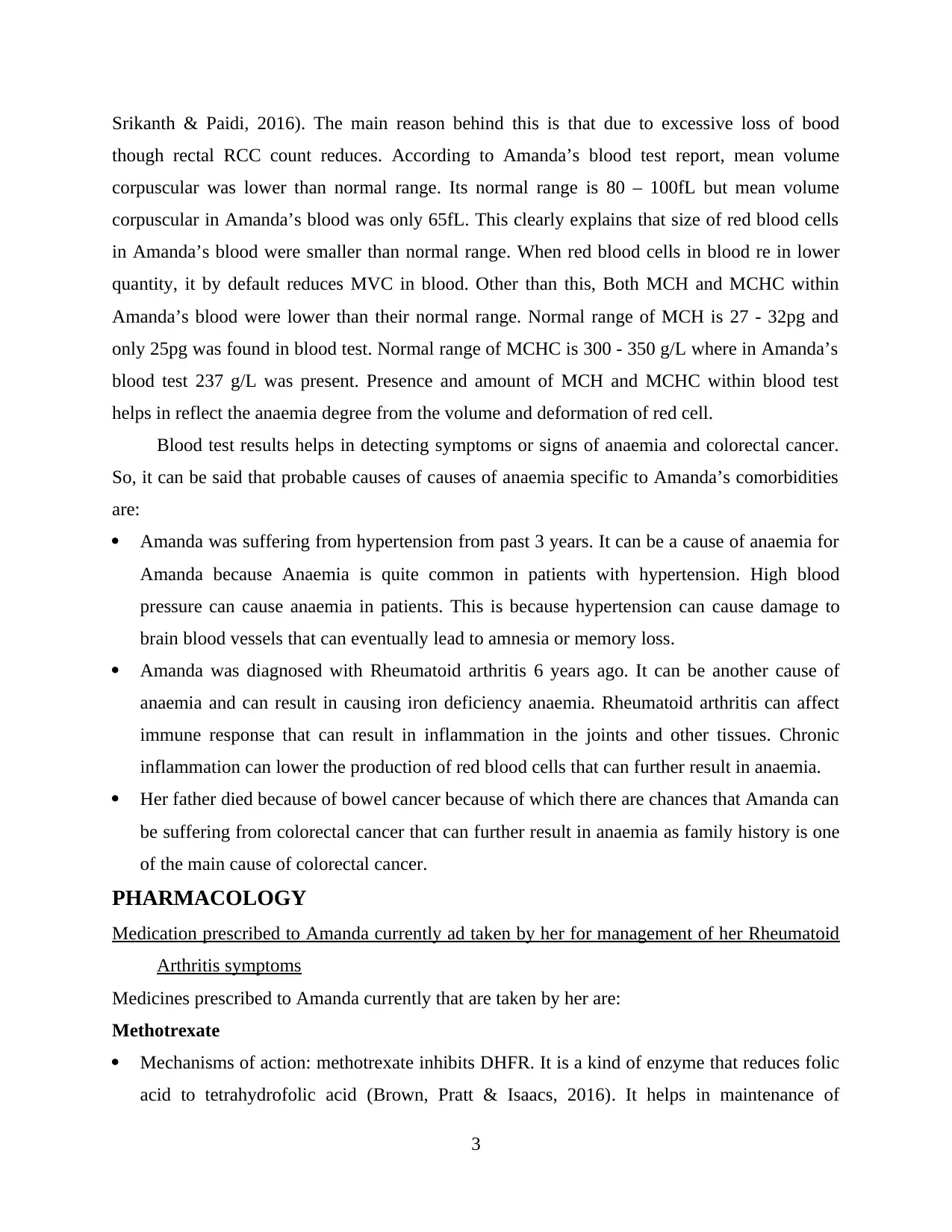
Srikanth & Paidi, 2016). The main reason behind this is that due to excessive loss of bood
though rectal RCC count reduces. According to Amanda’s blood test report, mean volume
corpuscular was lower than normal range. Its normal range is 80 – 100fL but mean volume
corpuscular in Amanda’s blood was only 65fL. This clearly explains that size of red blood cells
in Amanda’s blood were smaller than normal range. When red blood cells in blood re in lower
quantity, it by default reduces MVC in blood. Other than this, Both MCH and MCHC within
Amanda’s blood were lower than their normal range. Normal range of MCH is 27 - 32pg and
only 25pg was found in blood test. Normal range of MCHC is 300 - 350 g/L where in Amanda’s
blood test 237 g/L was present. Presence and amount of MCH and MCHC within blood test
helps in reflect the anaemia degree from the volume and deformation of red cell.
Blood test results helps in detecting symptoms or signs of anaemia and colorectal cancer.
So, it can be said that probable causes of causes of anaemia specific to Amanda’s comorbidities
are:
Amanda was suffering from hypertension from past 3 years. It can be a cause of anaemia for
Amanda because Anaemia is quite common in patients with hypertension. High blood
pressure can cause anaemia in patients. This is because hypertension can cause damage to
brain blood vessels that can eventually lead to amnesia or memory loss.
Amanda was diagnosed with Rheumatoid arthritis 6 years ago. It can be another cause of
anaemia and can result in causing iron deficiency anaemia. Rheumatoid arthritis can affect
immune response that can result in inflammation in the joints and other tissues. Chronic
inflammation can lower the production of red blood cells that can further result in anaemia.
Her father died because of bowel cancer because of which there are chances that Amanda can
be suffering from colorectal cancer that can further result in anaemia as family history is one
of the main cause of colorectal cancer.
PHARMACOLOGY
Medication prescribed to Amanda currently ad taken by her for management of her Rheumatoid
Arthritis symptoms
Medicines prescribed to Amanda currently that are taken by her are:
Methotrexate
Mechanisms of action: methotrexate inhibits DHFR. It is a kind of enzyme that reduces folic
acid to tetrahydrofolic acid (Brown, Pratt & Isaacs, 2016). It helps in maintenance of
3
though rectal RCC count reduces. According to Amanda’s blood test report, mean volume
corpuscular was lower than normal range. Its normal range is 80 – 100fL but mean volume
corpuscular in Amanda’s blood was only 65fL. This clearly explains that size of red blood cells
in Amanda’s blood were smaller than normal range. When red blood cells in blood re in lower
quantity, it by default reduces MVC in blood. Other than this, Both MCH and MCHC within
Amanda’s blood were lower than their normal range. Normal range of MCH is 27 - 32pg and
only 25pg was found in blood test. Normal range of MCHC is 300 - 350 g/L where in Amanda’s
blood test 237 g/L was present. Presence and amount of MCH and MCHC within blood test
helps in reflect the anaemia degree from the volume and deformation of red cell.
Blood test results helps in detecting symptoms or signs of anaemia and colorectal cancer.
So, it can be said that probable causes of causes of anaemia specific to Amanda’s comorbidities
are:
Amanda was suffering from hypertension from past 3 years. It can be a cause of anaemia for
Amanda because Anaemia is quite common in patients with hypertension. High blood
pressure can cause anaemia in patients. This is because hypertension can cause damage to
brain blood vessels that can eventually lead to amnesia or memory loss.
Amanda was diagnosed with Rheumatoid arthritis 6 years ago. It can be another cause of
anaemia and can result in causing iron deficiency anaemia. Rheumatoid arthritis can affect
immune response that can result in inflammation in the joints and other tissues. Chronic
inflammation can lower the production of red blood cells that can further result in anaemia.
Her father died because of bowel cancer because of which there are chances that Amanda can
be suffering from colorectal cancer that can further result in anaemia as family history is one
of the main cause of colorectal cancer.
PHARMACOLOGY
Medication prescribed to Amanda currently ad taken by her for management of her Rheumatoid
Arthritis symptoms
Medicines prescribed to Amanda currently that are taken by her are:
Methotrexate
Mechanisms of action: methotrexate inhibits DHFR. It is a kind of enzyme that reduces folic
acid to tetrahydrofolic acid (Brown, Pratt & Isaacs, 2016). It helps in maintenance of
3

intracellular pool of tetrahydrofolate one-carbon derivatives. Methotrexate can affect cancer
and rheumatoid arthritis by two different pathways
Normal Dosage: Normally 7.5–15 mg is taken once a week. Amanda was also provided with
7.5mg orally once per week
ADR’s: Most of the ADR’s are gastrointestinal in nature like chest tightness, infection, oral
ulcer, dry mouth, back pain, abdominal discomfort, severe vomiting and many more (ADR’s of
Methotrexate, 2020).
Specific nursing and poly pharmacy considerations: Alcohol should be avoided. It can cause
birth defects or miscarriages so birth control or other kind of precautions should be taken.
Regular medical check-up should be done with blood test to identify its effect.
Ibuprofen PRN
Mechanisms of action: It is non-selective inhibitor of an enzyme called cyclooxygenase that
helps in synthesis of prostaglandins (Shen & et.al., 2020).
Normal Dosage: normally 600 mg in every 4 hours can be given t patient
ADR’s: Upset stomach, nausea, vomiting, headache, diarrhea, constipation, dizziness, or
drowsiness may occur.
Specific nursing and poly pharmacy considerations: overdose of this drug should be avoided.
Ramipril
Mechanisms of action: It inhabits RAAS system by binding to ACE for preventing
conversion of angiotensin I to angiotensin II (Shi & et.al., 2016).
Normal Dosage: Normally maximum dose is 5mg twice a day or 10mg once a day. To
Amanda 5 mg daily dose is given to her.
ADR’s: Headache, dizziness, cough, weakness
Specific nursing and poly pharmacy considerations: While giving this medicine hypertension
of patient should be managed.
4
and rheumatoid arthritis by two different pathways
Normal Dosage: Normally 7.5–15 mg is taken once a week. Amanda was also provided with
7.5mg orally once per week
ADR’s: Most of the ADR’s are gastrointestinal in nature like chest tightness, infection, oral
ulcer, dry mouth, back pain, abdominal discomfort, severe vomiting and many more (ADR’s of
Methotrexate, 2020).
Specific nursing and poly pharmacy considerations: Alcohol should be avoided. It can cause
birth defects or miscarriages so birth control or other kind of precautions should be taken.
Regular medical check-up should be done with blood test to identify its effect.
Ibuprofen PRN
Mechanisms of action: It is non-selective inhibitor of an enzyme called cyclooxygenase that
helps in synthesis of prostaglandins (Shen & et.al., 2020).
Normal Dosage: normally 600 mg in every 4 hours can be given t patient
ADR’s: Upset stomach, nausea, vomiting, headache, diarrhea, constipation, dizziness, or
drowsiness may occur.
Specific nursing and poly pharmacy considerations: overdose of this drug should be avoided.
Ramipril
Mechanisms of action: It inhabits RAAS system by binding to ACE for preventing
conversion of angiotensin I to angiotensin II (Shi & et.al., 2016).
Normal Dosage: Normally maximum dose is 5mg twice a day or 10mg once a day. To
Amanda 5 mg daily dose is given to her.
ADR’s: Headache, dizziness, cough, weakness
Specific nursing and poly pharmacy considerations: While giving this medicine hypertension
of patient should be managed.
4
⊘ This is a preview!⊘
Do you want full access?
Subscribe today to unlock all pages.

Trusted by 1+ million students worldwide
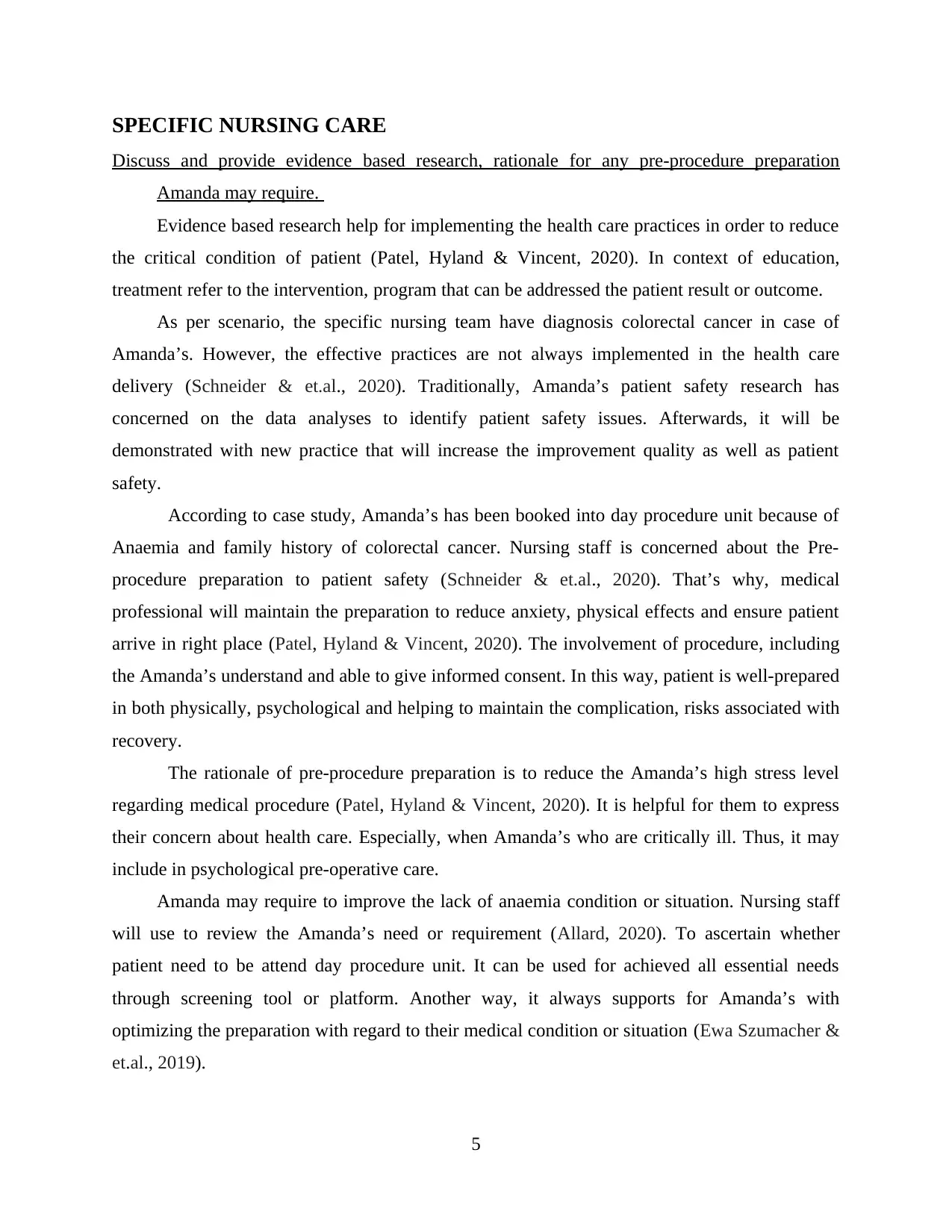
SPECIFIC NURSING CARE
Discuss and provide evidence based research, rationale for any pre-procedure preparation
Amanda may require.
Evidence based research help for implementing the health care practices in order to reduce
the critical condition of patient (Patel, Hyland & Vincent, 2020). In context of education,
treatment refer to the intervention, program that can be addressed the patient result or outcome.
As per scenario, the specific nursing team have diagnosis colorectal cancer in case of
Amanda’s. However, the effective practices are not always implemented in the health care
delivery (Schneider & et.al., 2020). Traditionally, Amanda’s patient safety research has
concerned on the data analyses to identify patient safety issues. Afterwards, it will be
demonstrated with new practice that will increase the improvement quality as well as patient
safety.
According to case study, Amanda’s has been booked into day procedure unit because of
Anaemia and family history of colorectal cancer. Nursing staff is concerned about the Pre-
procedure preparation to patient safety (Schneider & et.al., 2020). That’s why, medical
professional will maintain the preparation to reduce anxiety, physical effects and ensure patient
arrive in right place (Patel, Hyland & Vincent, 2020). The involvement of procedure, including
the Amanda’s understand and able to give informed consent. In this way, patient is well-prepared
in both physically, psychological and helping to maintain the complication, risks associated with
recovery.
The rationale of pre-procedure preparation is to reduce the Amanda’s high stress level
regarding medical procedure (Patel, Hyland & Vincent, 2020). It is helpful for them to express
their concern about health care. Especially, when Amanda’s who are critically ill. Thus, it may
include in psychological pre-operative care.
Amanda may require to improve the lack of anaemia condition or situation. Nursing staff
will use to review the Amanda’s need or requirement (Allard, 2020). To ascertain whether
patient need to be attend day procedure unit. It can be used for achieved all essential needs
through screening tool or platform. Another way, it always supports for Amanda’s with
optimizing the preparation with regard to their medical condition or situation (Ewa Szumacher &
et.al., 2019).
5
Discuss and provide evidence based research, rationale for any pre-procedure preparation
Amanda may require.
Evidence based research help for implementing the health care practices in order to reduce
the critical condition of patient (Patel, Hyland & Vincent, 2020). In context of education,
treatment refer to the intervention, program that can be addressed the patient result or outcome.
As per scenario, the specific nursing team have diagnosis colorectal cancer in case of
Amanda’s. However, the effective practices are not always implemented in the health care
delivery (Schneider & et.al., 2020). Traditionally, Amanda’s patient safety research has
concerned on the data analyses to identify patient safety issues. Afterwards, it will be
demonstrated with new practice that will increase the improvement quality as well as patient
safety.
According to case study, Amanda’s has been booked into day procedure unit because of
Anaemia and family history of colorectal cancer. Nursing staff is concerned about the Pre-
procedure preparation to patient safety (Schneider & et.al., 2020). That’s why, medical
professional will maintain the preparation to reduce anxiety, physical effects and ensure patient
arrive in right place (Patel, Hyland & Vincent, 2020). The involvement of procedure, including
the Amanda’s understand and able to give informed consent. In this way, patient is well-prepared
in both physically, psychological and helping to maintain the complication, risks associated with
recovery.
The rationale of pre-procedure preparation is to reduce the Amanda’s high stress level
regarding medical procedure (Patel, Hyland & Vincent, 2020). It is helpful for them to express
their concern about health care. Especially, when Amanda’s who are critically ill. Thus, it may
include in psychological pre-operative care.
Amanda may require to improve the lack of anaemia condition or situation. Nursing staff
will use to review the Amanda’s need or requirement (Allard, 2020). To ascertain whether
patient need to be attend day procedure unit. It can be used for achieved all essential needs
through screening tool or platform. Another way, it always supports for Amanda’s with
optimizing the preparation with regard to their medical condition or situation (Ewa Szumacher &
et.al., 2019).
5
Paraphrase This Document
Need a fresh take? Get an instant paraphrase of this document with our AI Paraphraser

Pre-procedure related to nursing care, discharge planning
Medicare states that discharge planning help for identifying current need or requirement of
patient and then move from one level to another. The nursing care is based on the effective Pre-
procedure plan that help for ensuring patient receive evidence based holistic care. Afterwards, it
diagnoses anaemia condition in Amanda’s. In context of nursing care, it must follow the different
pre-procedure activities for establishment of Amada’s baseline assessment. Afterwards, carrying
out the different processes.
Correcting and assessing both psychological as well as physiological problem, which
may increase during surgical risk.
Providing better counselling for patient in term of treatment.
Demonstrating as well as instructing the different exercise that will provide benefits for
Amanda’s patient.
Planning for discharge and projected change in current lifestyle.
By consideration of discharge planning within pre-procedure to decide Amanda’s needs for
smooth move from one level to another. Specialist doctor can authorise a patient release form the
hospital. The overall discharge planning can be completed by nursing staff members.
Discuss about the discharge education would be appropriate post colonoscopy taking into
account Amanda’s co-morbidities and associated risk factors.
Discharge education is based on the critical plan for identifying the suitable need and
requirement. It ensuring that patient’s take better treatment from hospital (Song, 2020).
The colonoscopy discharge is helping to examine the view inside of colon and rectum
with the help of Colonoscopy. In this way, it can be performed the initial stage to examine the
current condition of patient (Ewa Szumacher & et.al., 2019). Generally, nursing staff can follow
procedure involved in the post colonoscopy process taking into account Amanda’s Co-
morbidities and associated risk factors. It helps for Amanda’s to understand about the Post
colonoscopy concept and appropriate during discharge education.
Nursing staff and specialist doctor is focused on the discharge education in term of post
colonoscopy procedure and identifying quality of patient care (Ewa Szumacher & et.al., 2019).
These element ensure that Amanda’s as patient needs after discharge from hospital. It can
perform function at optimal level.
6
Medicare states that discharge planning help for identifying current need or requirement of
patient and then move from one level to another. The nursing care is based on the effective Pre-
procedure plan that help for ensuring patient receive evidence based holistic care. Afterwards, it
diagnoses anaemia condition in Amanda’s. In context of nursing care, it must follow the different
pre-procedure activities for establishment of Amada’s baseline assessment. Afterwards, carrying
out the different processes.
Correcting and assessing both psychological as well as physiological problem, which
may increase during surgical risk.
Providing better counselling for patient in term of treatment.
Demonstrating as well as instructing the different exercise that will provide benefits for
Amanda’s patient.
Planning for discharge and projected change in current lifestyle.
By consideration of discharge planning within pre-procedure to decide Amanda’s needs for
smooth move from one level to another. Specialist doctor can authorise a patient release form the
hospital. The overall discharge planning can be completed by nursing staff members.
Discuss about the discharge education would be appropriate post colonoscopy taking into
account Amanda’s co-morbidities and associated risk factors.
Discharge education is based on the critical plan for identifying the suitable need and
requirement. It ensuring that patient’s take better treatment from hospital (Song, 2020).
The colonoscopy discharge is helping to examine the view inside of colon and rectum
with the help of Colonoscopy. In this way, it can be performed the initial stage to examine the
current condition of patient (Ewa Szumacher & et.al., 2019). Generally, nursing staff can follow
procedure involved in the post colonoscopy process taking into account Amanda’s Co-
morbidities and associated risk factors. It helps for Amanda’s to understand about the Post
colonoscopy concept and appropriate during discharge education.
Nursing staff and specialist doctor is focused on the discharge education in term of post
colonoscopy procedure and identifying quality of patient care (Ewa Szumacher & et.al., 2019).
These element ensure that Amanda’s as patient needs after discharge from hospital. It can
perform function at optimal level.
6
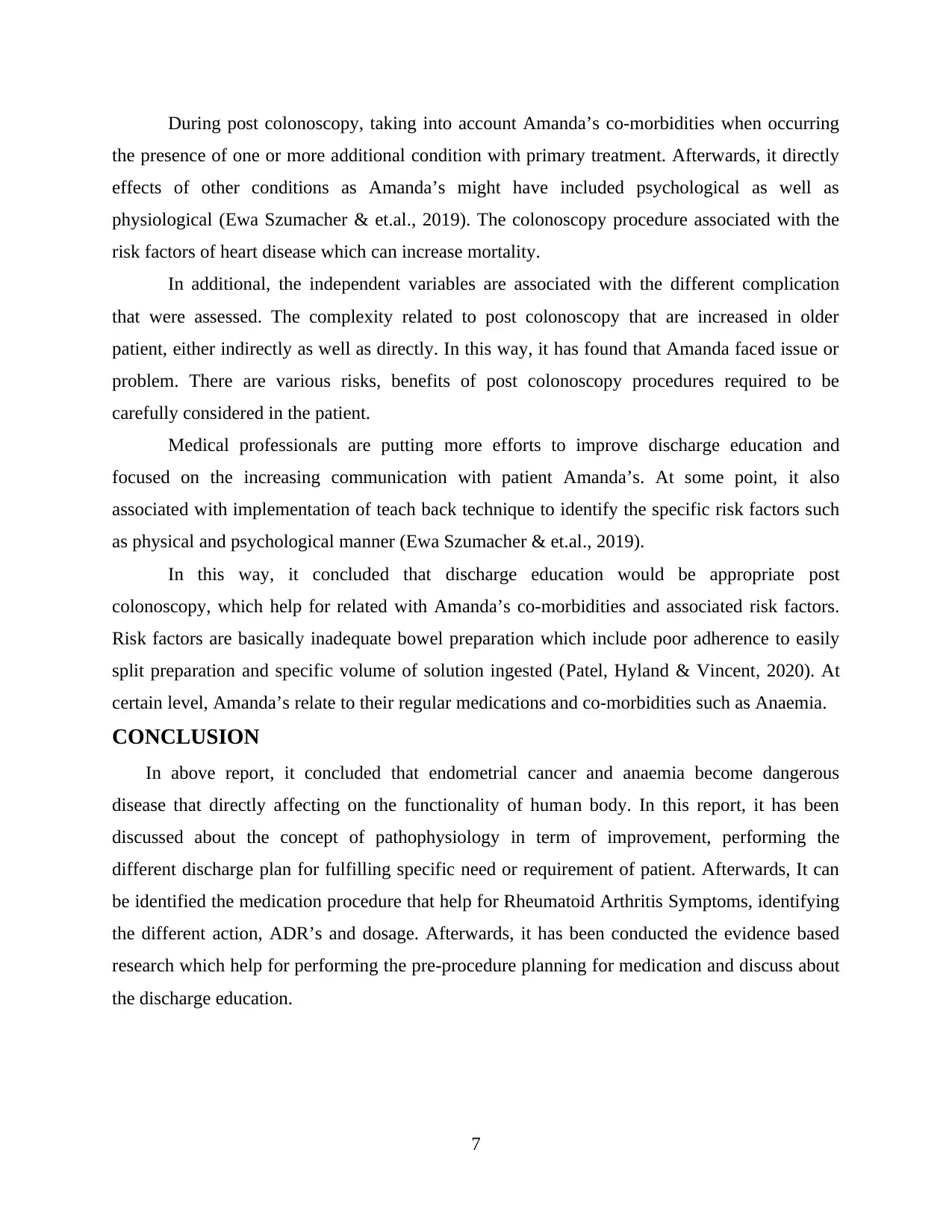
During post colonoscopy, taking into account Amanda’s co-morbidities when occurring
the presence of one or more additional condition with primary treatment. Afterwards, it directly
effects of other conditions as Amanda’s might have included psychological as well as
physiological (Ewa Szumacher & et.al., 2019). The colonoscopy procedure associated with the
risk factors of heart disease which can increase mortality.
In additional, the independent variables are associated with the different complication
that were assessed. The complexity related to post colonoscopy that are increased in older
patient, either indirectly as well as directly. In this way, it has found that Amanda faced issue or
problem. There are various risks, benefits of post colonoscopy procedures required to be
carefully considered in the patient.
Medical professionals are putting more efforts to improve discharge education and
focused on the increasing communication with patient Amanda’s. At some point, it also
associated with implementation of teach back technique to identify the specific risk factors such
as physical and psychological manner (Ewa Szumacher & et.al., 2019).
In this way, it concluded that discharge education would be appropriate post
colonoscopy, which help for related with Amanda’s co-morbidities and associated risk factors.
Risk factors are basically inadequate bowel preparation which include poor adherence to easily
split preparation and specific volume of solution ingested (Patel, Hyland & Vincent, 2020). At
certain level, Amanda’s relate to their regular medications and co-morbidities such as Anaemia.
CONCLUSION
In above report, it concluded that endometrial cancer and anaemia become dangerous
disease that directly affecting on the functionality of human body. In this report, it has been
discussed about the concept of pathophysiology in term of improvement, performing the
different discharge plan for fulfilling specific need or requirement of patient. Afterwards, It can
be identified the medication procedure that help for Rheumatoid Arthritis Symptoms, identifying
the different action, ADR’s and dosage. Afterwards, it has been conducted the evidence based
research which help for performing the pre-procedure planning for medication and discuss about
the discharge education.
7
the presence of one or more additional condition with primary treatment. Afterwards, it directly
effects of other conditions as Amanda’s might have included psychological as well as
physiological (Ewa Szumacher & et.al., 2019). The colonoscopy procedure associated with the
risk factors of heart disease which can increase mortality.
In additional, the independent variables are associated with the different complication
that were assessed. The complexity related to post colonoscopy that are increased in older
patient, either indirectly as well as directly. In this way, it has found that Amanda faced issue or
problem. There are various risks, benefits of post colonoscopy procedures required to be
carefully considered in the patient.
Medical professionals are putting more efforts to improve discharge education and
focused on the increasing communication with patient Amanda’s. At some point, it also
associated with implementation of teach back technique to identify the specific risk factors such
as physical and psychological manner (Ewa Szumacher & et.al., 2019).
In this way, it concluded that discharge education would be appropriate post
colonoscopy, which help for related with Amanda’s co-morbidities and associated risk factors.
Risk factors are basically inadequate bowel preparation which include poor adherence to easily
split preparation and specific volume of solution ingested (Patel, Hyland & Vincent, 2020). At
certain level, Amanda’s relate to their regular medications and co-morbidities such as Anaemia.
CONCLUSION
In above report, it concluded that endometrial cancer and anaemia become dangerous
disease that directly affecting on the functionality of human body. In this report, it has been
discussed about the concept of pathophysiology in term of improvement, performing the
different discharge plan for fulfilling specific need or requirement of patient. Afterwards, It can
be identified the medication procedure that help for Rheumatoid Arthritis Symptoms, identifying
the different action, ADR’s and dosage. Afterwards, it has been conducted the evidence based
research which help for performing the pre-procedure planning for medication and discuss about
the discharge education.
7
⊘ This is a preview!⊘
Do you want full access?
Subscribe today to unlock all pages.

Trusted by 1+ million students worldwide

REREFENCES
Books and Journals
Allard, B. L. (2020). INSPIREd Healthcare: A Value-Based Care Coordination Model. Sigma
Theta Tau.
Anumolu, V. N. S. H., Srikanth, A., & Paidi, K. (2016). Evaluation of the relation between
anemia and periodontitis by estimation of blood parameters: A cross-sectional
study. Journal of Indian Society of Periodontology, 20(3), 265.
Brown, P. M., Pratt, A. G., & Isaacs, J. D. (2016). Mechanism of action of methotrexate in
rheumatoid arthritis, and the search for biomarkers. Nature Reviews
Rheumatology, 12(12), 731-742.
Ewa Szumacher, M. D. & et.al., (2019). 2019 International Cancer Education
Conference. Journal of Cancer Education. 34(1). S1-S58.
Patel, G. P., Hyland, S. J. & Vincent III, W. R. (2020). Perioperative clinical pharmacy practice:
Responsibilities and scope within the surgical care continuum. Journal of the American
College of Clinical Pharmacy. 3(2). 501-519.
Schneider, J. L. & et.al., (2020). Barriers and facilitators to timely colonoscopy completion for
safety net clinic patients. American journal of health behavior. 44(4). 460-472.
Shen, W. & et.al., (2020). Ibuprofen mediates histone modification to diminish cancer cell
stemness properties via a COX2-dependent manner. British Journal of Cancer, 1-12.
Shi, J. H. & et.al., 2016). Binding interaction of ramipril with bovine serum albumin (BSA):
insights from multi-spectroscopy and molecular docking methods. Journal of
Photochemistry and Photobiology B: Biology, 164, 103-111.
Song, J. (2020). Analyzing Risk Factors for Healthcare-Associated Infections Using Multiple
Methodological Approaches (Doctoral dissertation, Columbia University).
Zhang, M. & et.al., (2020). Physiological and pathophysiological role of ion channels and
transporters in the colorectum and colorectal cancer. Journal of Cellular and Molecular
Medicine.
Online
ADR’s of Methotrexate. 2020. [Online]. Available though: <
https://www.webmd.com/drugs/2/drug-3441/methotrexate-anti-rheumatic-oral/details>
8
Books and Journals
Allard, B. L. (2020). INSPIREd Healthcare: A Value-Based Care Coordination Model. Sigma
Theta Tau.
Anumolu, V. N. S. H., Srikanth, A., & Paidi, K. (2016). Evaluation of the relation between
anemia and periodontitis by estimation of blood parameters: A cross-sectional
study. Journal of Indian Society of Periodontology, 20(3), 265.
Brown, P. M., Pratt, A. G., & Isaacs, J. D. (2016). Mechanism of action of methotrexate in
rheumatoid arthritis, and the search for biomarkers. Nature Reviews
Rheumatology, 12(12), 731-742.
Ewa Szumacher, M. D. & et.al., (2019). 2019 International Cancer Education
Conference. Journal of Cancer Education. 34(1). S1-S58.
Patel, G. P., Hyland, S. J. & Vincent III, W. R. (2020). Perioperative clinical pharmacy practice:
Responsibilities and scope within the surgical care continuum. Journal of the American
College of Clinical Pharmacy. 3(2). 501-519.
Schneider, J. L. & et.al., (2020). Barriers and facilitators to timely colonoscopy completion for
safety net clinic patients. American journal of health behavior. 44(4). 460-472.
Shen, W. & et.al., (2020). Ibuprofen mediates histone modification to diminish cancer cell
stemness properties via a COX2-dependent manner. British Journal of Cancer, 1-12.
Shi, J. H. & et.al., 2016). Binding interaction of ramipril with bovine serum albumin (BSA):
insights from multi-spectroscopy and molecular docking methods. Journal of
Photochemistry and Photobiology B: Biology, 164, 103-111.
Song, J. (2020). Analyzing Risk Factors for Healthcare-Associated Infections Using Multiple
Methodological Approaches (Doctoral dissertation, Columbia University).
Zhang, M. & et.al., (2020). Physiological and pathophysiological role of ion channels and
transporters in the colorectum and colorectal cancer. Journal of Cellular and Molecular
Medicine.
Online
ADR’s of Methotrexate. 2020. [Online]. Available though: <
https://www.webmd.com/drugs/2/drug-3441/methotrexate-anti-rheumatic-oral/details>
8
1 out of 10
Related Documents
Your All-in-One AI-Powered Toolkit for Academic Success.
+13062052269
info@desklib.com
Available 24*7 on WhatsApp / Email
![[object Object]](/_next/static/media/star-bottom.7253800d.svg)
Unlock your academic potential
Copyright © 2020–2025 A2Z Services. All Rights Reserved. Developed and managed by ZUCOL.





